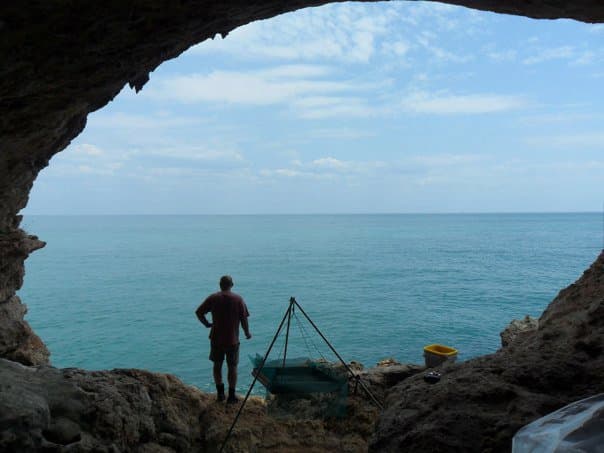Pretende partilhar este texto? Utilize as ferramentas de partilha que encontra na página de artigo.
Todos os conteúdos da VISÃO são protegidos por Direitos de Autor ao abrigo da legislação portuguesa. Apoie o jornalismo de qualidade, não partilhe violando Direitos de Autor.
Let’s do the necessary exercise of imagination. Let’s go back 90 thousand years in the calendar and situate ourselves in the Figueira Brava cave, next to Portinho, in the middle of the Arrábida Mountains, in a small protected room with a privileged view of the ocean. The sea will be about 1.5 kilometers away, but the rest of the landscape will not vary much from what can be seen from there.
In this naturally excavated recess in the rock will live a group of Neanderthal men from the Middle Paleolithic. It smells of embers and freshly made food. There are fat, one-pound cobblers cooking on the fire. The stone tools have been prepared to break their shells and pincers so that they can access the tasty meat. A 21st century-style meal is in place. But this they did not know.
Neither they nor the team of archaeologists that went to the field in 2010, with the intention of exploring the area, taking samples to better date the site, in the search for more evidence of Neanderthal presence in those parts. There had already been excavations in the 1980s that attested to this occupation 90,000 years ago.
As soon as the prospecting work began, clamps jumped out, soon identified as belonging to cobblers. And, we imagine, someone must have pulled out a cell phone, taken lots of poor resolution pictures, and shouted, “Eureka!”

Eureka because this discovery represents yet another find to the fire of the discussion surrounding the developmental status of Neanderthal man, for years relegated to a corner with donkey ears.
This Portuguese find was so important to the international archaeological community that, 10 years later, it was published, exclusively, in the prestigious journal Science, even if it was only preliminary results.
This month, the team led by archaeologist Mariana Nabais – who works at the Catalan Institute of Human Paleoecology and Social Evolution, in Tarragona – and João Zilhão, together with French archaeologist Chaterine Dupont, were able to publish in Frontiers in Environmental Archaeology the follow-up to this 2020 paper. Now, the team has prepared a detailed study of the marks that prove how the cobblers were caught and eaten by the Neanderthals present in the territory.

“From the start, it was clear from the fractures in the clamps that they were broken in the same way we do today, and the traces of burns at 300/500 degrees centigrade prove that they were cooked over hot coals and then eaten,” explains Mariana Nabais, the main author of the publication.
This was the first time that a set of crabs from Neanderthal times has been studied. These critters were usually under water, which is why their remains are so hard to find, especially because of sea level rise over the centuries.
So this is further proof that the people living here would have to know something about tides, because they could only hunt them alive when they approached the shore and got stuck in the small puddles that formed at low tide.
Since no one had ever looked at these animals before, the research team had to follow the prevailing fracture patterns for shells. However, to prove that this pattern transfer was adequate, the archaeologists bought cobblers of the same dimensions as those found, lit the coals, cooked them, and broke them with utensils like those of the time under study. All the conclusions they had reached were confirmed – and this experiment is described in a paper already submitted to scientific journals, awaiting publication.
“There is a great debate concerning Neanderthals. For years they have been attributed characteristics of brutality and inability to do certain activities. It is true that they were hominids, but they didn’t just hunt mammoths, as studies from Northern Europe – where there is generally more money for this type of research – have suggested over time,” explains the archaeologist.
Ever since excavations were done in southern Europe, it was realized that this was a rather limited idea. Fortunately, and because of research like this in Portugal, the image of Neanderthal men is being rehabilitated. “It is now known that they produced art, used ornaments, ate some fish and shells. Basically, their behavior was very similar to that of homo sapiens,” he concludes. In other words, there is still Neanderthal genetic code in all of us.









